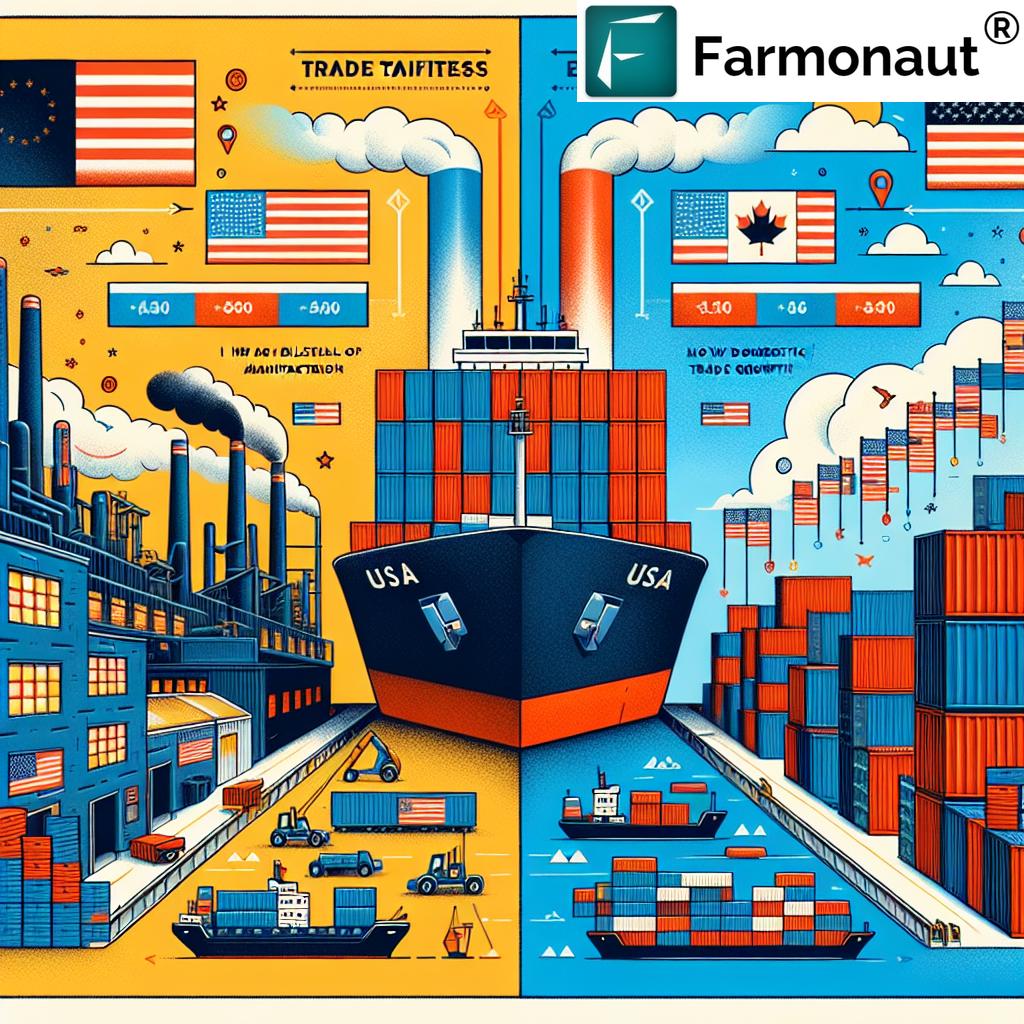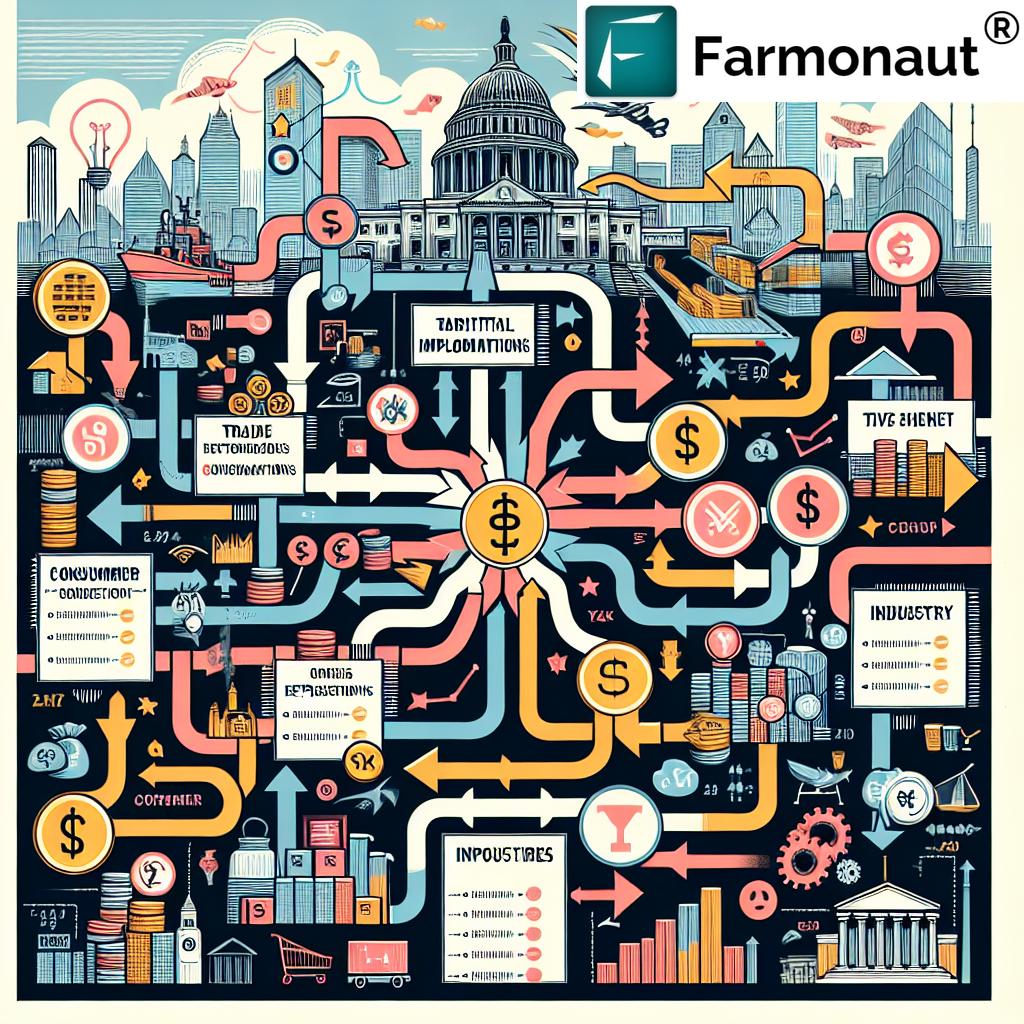Reciprocal Tariffs: How New Trade Policies Impact US Economic Growth and Consumer Prices

“The new U.S. reciprocal tariff plan considers at least 3 factors: value-added taxes, subsidies, and regulations to calculate import taxes.”
In the ever-evolving landscape of global trade, the United States has taken a bold step with its new reciprocal tariff plan. This policy shift aims to level the playing field for domestic manufacturers and address trade imbalances. As we delve into the intricacies of this plan, we’ll explore its potential impacts on U.S. economic growth, consumer prices, and international trade relationships.
Understanding Reciprocal Tariffs
Reciprocal tariffs are a trade policy strategy where a country imposes import taxes that match or mirror those of its trading partners. The concept is rooted in the principle of fairness in international trade. By implementing this approach, the U.S. administration seeks to address perceived inequities in existing trade agreements and practices.
Key aspects of the new reciprocal tariff plan include:
- Matching import taxes with those of trading partners
- Considering value-added taxes, subsidies, and regulations in calculations
- Aiming to eliminate trade imbalances
- Potentially triggering new trade negotiations
As we analyze this policy, it’s crucial to understand its multifaceted nature and far-reaching implications. Let’s break down the various components and potential outcomes.
The Economics Behind Reciprocal Tariffs
The implementation of reciprocal tariffs is rooted in economic theory and policy objectives. Here’s a closer look at the underlying principles:
- Trade Balance: By matching tariffs, the U.S. aims to reduce trade deficits and create a more balanced exchange of goods and services with its trading partners.
- Domestic Industry Protection: Higher tariffs on imports can potentially shield U.S. manufacturers from foreign competition, encouraging domestic production.
- Revenue Generation: Increased tariffs could boost government revenue, potentially helping to address budget deficits.
- Negotiation Leverage: The threat of reciprocal tariffs may serve as a bargaining chip in future trade negotiations.
While these objectives seem straightforward, the actual economic impacts can be complex and multifaceted.
Potential Impact on U.S. Economic Growth
The effects of reciprocal tariffs on U.S. economic growth are subject to debate among economists and policymakers. Let’s examine the potential outcomes:
Short-term Effects
- Manufacturing Boost: Some domestic industries may see increased demand as imported goods become more expensive.
- Job Creation: Certain sectors might experience job growth as production shifts back to the U.S.
- Market Volatility: Financial markets may react to policy changes, leading to short-term fluctuations.
Long-term Projections
- Trade Relationship Shifts: Prolonged tariffs could alter global supply chains and trade partnerships.
- Innovation Impacts: Reduced competition might affect innovation rates in certain industries.
- Economic Restructuring: The economy may undergo structural changes as industries adapt to new trade realities.
It’s important to note that economic growth is influenced by numerous factors, and the impact of tariffs alone can be challenging to isolate.
Consumer Prices and Inflation Concerns
One of the most immediate and tangible effects of reciprocal tariffs could be on consumer prices. Here’s what American consumers might expect:
- Price Increases: Imported goods may become more expensive, potentially leading to higher consumer prices across various sectors.
- Inflationary Pressure: As costs rise, there’s a risk of broader inflationary trends in the economy.
- Purchasing Power: If wage growth doesn’t keep pace with price increases, consumers’ purchasing power could be affected.
The extent of these effects will depend on factors such as the specific goods targeted, the elasticity of demand, and the availability of domestic alternatives.
Impact on U.S. Businesses
American businesses, from small enterprises to large corporations, are likely to feel the effects of reciprocal tariffs in various ways:
Challenges
- Input Costs: Companies relying on imported materials may face higher production costs.
- Supply Chain Disruptions: Established supply chains might need restructuring, leading to temporary inefficiencies.
- Market Access: Retaliatory tariffs from other countries could limit access to foreign markets for U.S. exporters.
Opportunities
- Domestic Market Share: Some businesses may benefit from reduced foreign competition in the U.S. market.
- Innovation Incentives: The need to adapt could drive innovation in production methods and product development.
- Reshoring: There may be increased opportunities for businesses looking to bring production back to the U.S.
“Reciprocal tariffs could impact 4 key areas: consumer prices, business operations, global trade relationships, and U.S. economic growth.”
As businesses navigate these changes, adaptability and strategic planning will be crucial for success in the new trade environment.
Global Trade Relationships and Negotiations
The implementation of reciprocal tariffs is likely to have significant implications for U.S. trade relationships and ongoing negotiations:
- Renegotiation of Trade Agreements: Existing trade deals may need to be revisited and potentially renegotiated.
- Diplomatic Tensions: There’s a risk of strained diplomatic relations with key trading partners.
- Global Economic Impact: Changes in U.S. trade policy could have ripple effects throughout the global economy.
- New Alliances: The shifting trade landscape may lead to new economic partnerships and alliances.
As the U.S. navigates these complex international waters, the balance between asserting trade fairness and maintaining positive global relationships will be crucial.
Comparative Analysis of Reciprocal Tariffs Impact
| Economic Factor | Current Situation | Projected Impact (Short-term) | Projected Impact (Long-term) |
|---|---|---|---|
| Consumer Prices | 3% inflation rate | Potential 5-7% increase | Stabilization at 4-5% higher levels |
| Domestic Manufacturing | Moderate growth | 10-15% boost in certain sectors | Sustained 5-8% growth, with variability |
| International Trade Relations | Generally stable | Increased tensions, potential retaliations | New trade agreements, shifted alliances |
| U.S. Economic Growth | 2.5% annual GDP growth | Possible slowdown to 1.5-2% | Potential return to 2-3% with adjustments |
| Government Revenue | $3.5 trillion annually | Potential 5-10% increase from tariffs | Stabilization, dependent on trade volumes |
Political Implications and Public Opinion
The implementation of reciprocal tariffs is not just an economic decision but also a political one with significant implications:
- Voter Sentiment: Public opinion on tariffs can sway based on their perceived impact on jobs and prices.
- Political Debates: Trade policy is likely to become a central issue in upcoming elections and political discourse.
- International Relations: The stance on trade could affect broader diplomatic relationships and alliances.
- Policy Continuity: Future administrations may need to decide whether to continue or modify the reciprocal tariff approach.
As policymakers navigate these waters, balancing economic objectives with political realities will be crucial.
Alternatives and Complementary Strategies
While reciprocal tariffs are a significant policy shift, they are not the only tool available for addressing trade imbalances and promoting economic growth. Other strategies that could complement or serve as alternatives include:
- Investment in Innovation: Boosting R&D funding to enhance competitiveness in key industries.
- Workforce Development: Investing in education and training to build a skilled workforce for emerging industries.
- Regulatory Reform: Streamlining regulations to make U.S. businesses more competitive globally.
- Targeted Subsidies: Supporting strategic industries through government incentives and subsidies.
- Digital Trade Policies: Developing frameworks for fair competition in the growing digital economy.
These approaches could work in tandem with tariff policies to create a comprehensive strategy for economic growth and trade fairness.
The Role of Technology in Trade Policy Implementation
In the modern era, technology plays a crucial role in implementing and monitoring trade policies. Advanced systems are necessary for:
- Data Analysis: Processing vast amounts of trade data to inform policy decisions.
- Customs Enforcement: Enhancing border control and tariff collection efficiency.
- Supply Chain Tracking: Monitoring global supply chains for compliance and fairness.
- Economic Modeling: Using AI and machine learning to predict policy impacts.
As we consider the implementation of reciprocal tariffs, the role of technology in ensuring effectiveness and fairness cannot be overstated.
Environmental Considerations
Trade policies, including reciprocal tariffs, can have significant environmental implications:
- Carbon Footprint: Changes in trade patterns may affect global shipping and associated emissions.
- Resource Allocation: Shifts in production locations could impact resource use and sustainability practices.
- Green Technology Trade: Tariffs might influence the global exchange of environmental technologies.
- Regulatory Standards: Trade negotiations could affect the adoption of environmental standards across borders.
Balancing economic objectives with environmental sustainability will be a key challenge in implementing new trade policies.
FAQs About Reciprocal Tariffs
- Q: What exactly are reciprocal tariffs?
A: Reciprocal tariffs are import taxes set to match those imposed by trading partners, aiming to create a level playing field in international trade. - Q: How might reciprocal tariffs affect consumer prices?
A: They could lead to higher prices for imported goods, potentially increasing overall consumer prices in the short to medium term. - Q: Will reciprocal tariffs create more jobs in the U.S.?
A: While they may boost certain domestic industries, the overall impact on employment is complex and depends on various economic factors. - Q: How might other countries respond to U.S. reciprocal tariffs?
A: Trading partners may impose retaliatory tariffs, potentially leading to trade disputes or renegotiations of existing agreements. - Q: What industries are most likely to be affected by reciprocal tariffs?
A: Industries heavily reliant on international trade, such as manufacturing, agriculture, and technology, are likely to see significant impacts.
Conclusion: Navigating the New Trade Landscape
As we’ve explored, the implementation of reciprocal tariffs represents a significant shift in U.S. trade policy with far-reaching implications for economic growth, consumer prices, and global trade relationships. While the policy aims to address trade imbalances and promote fairness, its effects are complex and multifaceted.
Key takeaways include:
- Potential short-term disruptions in prices and supply chains
- Long-term structural changes in the U.S. economy and global trade patterns
- The need for businesses and consumers to adapt to new economic realities
- Ongoing negotiations and potential shifts in international alliances
- The importance of complementary strategies for comprehensive economic growth
As we move forward, it will be crucial for policymakers, businesses, and consumers to stay informed and adaptable. The success of reciprocal tariffs will ultimately be judged by their ability to foster fair trade, support U.S. economic growth, and maintain positive international relationships in an increasingly interconnected global economy.
As we navigate these complex trade issues, it’s worth noting that various sectors, including agriculture, are experiencing technological transformations that could influence trade dynamics. For instance, companies like Farmonaut are leveraging satellite technology and AI to revolutionize agricultural practices, potentially impacting crop yields and trade in agricultural goods.
While not directly related to tariff policies, such technological advancements in agriculture and other sectors could play a role in shaping future trade relationships and economic growth strategies. As we continue to monitor the effects of reciprocal tariffs, it will be important to consider how technological innovations across various industries might interact with and potentially mitigate some of the challenges posed by changing trade policies.

In conclusion, as we continue to analyze and adapt to the implementation of reciprocal tariffs, it’s clear that the policy’s success will depend on careful management, ongoing assessment, and the ability to balance multiple economic and political factors. The coming years will be crucial in determining whether this approach achieves its goals of fairness and growth in international trade.






